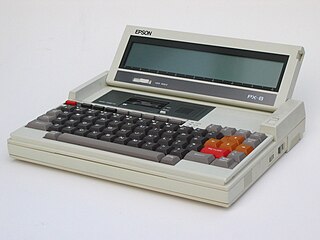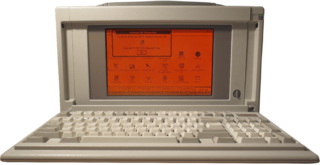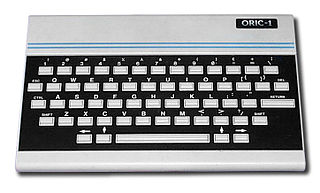
The Sinclair ZX80 is a home computer launched on 29 January 1980 by Science of Cambridge Ltd.. It is notable for being one of the first computers available in the United Kingdom for less than a hundred pounds. It was available in kit form for £79.95, where purchasers had to assemble and solder it together, and as a ready-built version at £99.95.

The LINC is a 12-bit, 2048-word transistorized computer. The LINC is considered by some to be the first minicomputer and a forerunner to the personal computer. Originally named the Linc, suggesting the project's origins at MIT's Lincoln Laboratory, it was renamed LINC after the project moved from the Lincoln Laboratory. The LINC was designed by Wesley A. Clark and Charles Molnar.

The Nascom 1 and 2 were single-board computer kits issued in the United Kingdom in 1977 and 1979, respectively, based on the Zilog Z80 and including a keyboard and video interface, a serial port that could be used to store data on a tape cassette using the Kansas City standard, and two 8-bit parallel ports. At that time, including a full keyboard and video display interface was uncommon, as most microcomputer kits were then delivered with only a hexadecimal keypad and seven-segment display. To minimize cost, the buyer had to assemble a Nascom by hand-soldering about 3,000 joints on the single circuit board. Later on, a pre-built, cased machine named Nascom 3 was available; this used the Nascom 2 board.

The Acorn Atom is a home computer made by Acorn Computers Ltd from 1979 to 1982, when it was replaced by the BBC Micro. The BBC Micro began life as an upgrade to the Atom, originally known as the Proton.

The Osborne 1 is the first commercially successful portable computer, released on April 3, 1981 by Osborne Computer Corporation. It weighs 24.5 lb (11.1 kg), cost US$1,795, and runs the CP/M 2.2 operating system. It is powered from a wall socket, as it has no on-board battery, but it is still classed as a portable device since it can be hand-carried when the keyboard is closed.

A portable computer is a computer designed to be easily moved from one place to another, as opposed to those designed to remain stationary at a single location such as desktops and workstations. These computers usually include a display and keyboard that are directly connected to the main case, all sharing a single power plug together, much like later desktop computers called all-in-ones (AIO) that integrate the system's internal components into the same case as the display. In modern usage, a portable computer usually refers to a very light and compact personal computer such as a laptop, miniature or pocket-sized computer, while touchscreen-based handheld ("palmtop") devices such as tablet, phablet and smartphone are called mobile devices instead.

The Apple IIc is a personal computer that was introduced by Apple Inc. shortly after the launch of the original Macintosh. It was a compact and portable version of the Apple II series of computers. The IIc featured a built-in floppy disk drive and a keyboard, and was often sold with its matching monitor. The c in the name stood for compact, referring to the fact it was a complete Apple II computer setup with a floppy drive that was squeezed into a smaller notebook-sized housing. It was compatible with a wide range of software and peripherals.

The IBM 5100 Portable Computer is one of the first portable computers, introduced in September 1975, six years before the IBM Personal Computer, and eight before the first successful IBM compatible portable computer, the Compaq Portable. It was the evolution of a prototype called the SCAMP that was developed at the IBM Palo Alto Scientific Center in 1973. Whether considered evolutionary from SCAMP or revolutionary, it still needed to be plugged into an electric socket.

The Rockwell AIM-65 computer is a development computer introduced in 1978 based on the MOS Technology 6502 microprocessor. The AIM-65 is essentially an expanded KIM-1 computer. Available software included a line-oriented machine code monitor, BASIC interpreter, assembler, Pascal, PL/65, and Forth development system. Available hardware included a floppy disk controller and a backplane for expansion.

Jean-Daniel Nicoud, is a Swiss computer scientist, noted for inventing of a computer mouse with an optical encoder and the CALM.
Calma Company, based in Sunnyvale, California, was, between 1965 and 1988, a vendor of digitizers and minicomputer-based graphics systems targeted at the cartographic and electronic, mechanical and architectural design markets.

The Compukit UK101 microcomputer (1979) is a kit clone of the Ohio Scientific Superboard II single-board computer, with a few enhancements for the UK market - notably replacing the 24×24 screen display with a more useful 48×16 layout working at UK video frequencies. The video output is black and white with 256 semigraphic characters generated by a two kilobyte ROM. It has no bit-mapped graphics capability. The video is output through a UHF modulator, designed to connect to a TV set.

The TRS-80 Model 100 is a portable computer introduced in April 1983. It is one of the first notebook-style computers, featuring a keyboard and liquid-crystal display, in a battery-powered package roughly the size and shape of a notepad or large book. The 224-page, spiral-bound User Manual is nearly the same size as the computer itself.

The Epson PX-8 a.k.a. Geneva was a small laptop computer made by the Epson Corporation in the mid-1980s.

The Tangerine Microtan 65 was a 6502 based single board microcomputer, first sold in 1979, which could be expanded into, what was for its day, a comprehensive and powerful system. The design became the basis for what later became the Oric Atmos and later computers, which has similar keyboard addressing and tape I/O as in the Microtan 65. The Microtan 65 has a single step function that can be used for debugging at the hardware level. The computer was available as ready-built boards or as kits consisting of board and components requiring soldering together.

The Epson HX-20 was the first "true" laptop computer. It was invented in July 1980 by Yukio Yokozawa, who worked for Suwa Seikosha, a branch of Japanese company Seiko, receiving a patent for the invention. It was announced in 1981 as the HC-20 in Japan, and was introduced by Epson in North America as the HX-20 at the 1981 COMDEX computer show in Las Vegas, where it drew significant attention for its portability. It had a mass-market release in July 1982, as the HC-20 in Japan and as the Epson HX-20 in North America. The size of an A4 notebook and weighing 1.6 kg, it was hailed by BusinessWeek magazine as the "fourth revolution in personal computing".

A backup camera is a video camera that is produced specifically for the purpose of being attached to the rear of a vehicle to aid in backing up and to reduce the rear blind spot. The rear blind spot has been described as a "killing zone" because of the accidents it contributes to. Backup cameras are usually connected to the vehicle's head unit display. A common variant is a surround-view system, which assembles a synthetic but positionally accurate top-down view of the vehicle and its adjacencies.

In computing, an input device is a piece of equipment used to provide data and control signals to an information processing system, such as a computer or information appliance. Examples of input devices include keyboards, computer mice, scanners, cameras, joysticks, and microphones.

The Compaq Portable 386 is a computer released by Compaq Computer Corporation in 1987. It was equipped with a 20 MHz Intel 80386 CPU, 1 MB RAM, 16 KB ROM, 1.2 MB5¼-inch floppy, 40 or 100 MB hard disk drive, priced at US$7,999 or 9,999 respectively, and a 10" amber gas-plasma display.

Oric was the name used by UK-based Tangerine Computer Systems for a series of 6502A-based home computers sold in the 1980s, primarily in Europe.





















